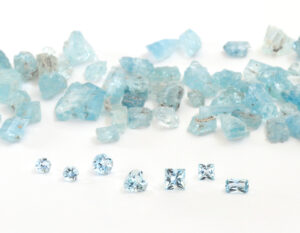By Jennifer Heebner, Editor in Chief
While you may know the Centennial State for intoxicatingly beautiful landscapes, ski resorts, and a certain plant that’s legal to smoke, did you know that Colorado is also a source of Aquamarine? Those who are traveling to AGTA GemFairTM Denver, Sept. 15–18, can see some firsthand at the Columbia Gem House booth, #HS320.
Aquamarine was first found in Colorado in 1880 near the summit of Mount White, including Mount Antero. Wikipedia maintains that Mount Antero is the “highest summit of the southern Sawatch Range of the Rocky Mountains” and is a “prominent 14,276-foot fourteener [having an elevation of at least 14,000 feet] located in San Isabel National Forest.” If you wanted to drive to it, the mine is about 12 miles from Buena Vista, Colo., in Chaffee County.

Mark Krivanek has owned the Chip-n-dale Mine on Mount White, part of Mount Antero, since 1998. The peaks are formed of granite rocks with pegmatite bodies that contain gem-quality crystals, including Aquamarine, colorless Topaz, smoky Quartz, and Phenakite.
At his mine, Krivanek obtains about 3 kilos of rough Aquamarine annually in sizes ranging from 1 to 10 grams, for four weeks in August. That’s it—he’s got a month to snatch up all the specimens he can find before the cold sets in.


“The mine is on a northern exposure, and permafrost covers the ground the rest of the year,” he explains. “The elevation is 12,800 to 13,400 feet and is a location under winter conditions nearly year-round.”
Chip-n-dale is a bench mining operation—a long narrow strip of land bound by steeper surrounding slopes—featuring a small excavator to move large rock, followed by hand sorting.

“Mining occurs in the talus slopes [debris that piles up on an angle] on the mountain, which means it is not required to dig deep to find,” Krivanek continues. “The Aqua is in the rubble or broken-down material of the mountain.”
Compared to other locations where Aquamarine is found, Colorado’s Aquamarine is similar in color and clarity; it’s just the limited availability and accessibility of the mine that makes it different.
While Krivanek has a retail shop and has sold the material locally in the past, he now intends to work exclusively with Columbia Gem House for cutting and wholesale distribution.

“If you know Columbia Gem House, you know we love to share a good story about colored gems,” says Natasha Braunwart, who’s been watching her dad Eric bring thousands of carats of gems with traceable origins to American consumers for decades. Eric, like many of his AGTA peers, is a pioneer in the mine-to-market space, so it’s not surprising that this American Aqua has big appeal to his clientele.
“Getting your hands on this sky-blue American material is something special,” Natasha explains. That’s why her family’s firm is introducing a range of calibrated small Colorado Aqua stones as well as large unique one-of-a-kind gems.
“[Columbia Gem House is] known for cutting American gemstones, and we felt it would be a great addition to our American Gems Collection,” she says. “Since Aqua has become a popular gem variety for engagement rings and jewelry design, we are excited to have this option for our customers. Many do not even know American Aqua exists!”
She says they met Krivanek about a year ago and have been actively developing available goods for the last six months.
Keystone prices for material start at $250 per carat up to $500 per carat. Available gems range in size from 0.15 ct. to 3 cts. in round, emerald cut, cushion, princess cut, and oval shapes.
Though they just missed the short seasonal window for a site visit in 2023, you can be sure it’s on their 2024 calendar. “We plan to visit next year,” Natasha confirms.
This is proprietary content for AGTA and may not be reproduced.
